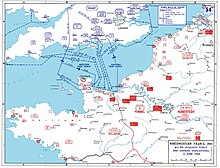

This article needs additional citations for verification. Please help improve this articlebyadding citations to reliable sources. Unsourced material may be challenged and removed.
Find sources: "Fortress Europe" – news · newspapers · books · scholar · JSTOR (March 2016) (Learn how and when to remove this message) |

Fortress Europe (German: Festung Europa) was a military propaganda term used by both sides of World War II which referred to the areas of Continental Europe occupied by Nazi Germany, as opposed to the United Kingdom across the Channel.

In British phraseology, Fortress Europe meant the battle honour accorded to Royal Air Force and Allied squadrons during the war, but to qualify, operations had to be made by aircraft based in Britain against targets in Germany, Italy and other parts of German-occupied Europe, in the period from the fall of France to the Normandy invasion.[citation needed]
Simultaneously, the term Festung Europa was being used by Nazi propaganda, namely to refer to Hitler's and the Wehrmacht's plans to fortify the whole of occupied Europe, in order to prevent an invasion by Allied forces. These measures included the construction of the Atlantic wall, along with the reorganization of the Luftwaffe for air defence. This use of the term Fortress Europe was subsequently adopted by correspondents and historians in the English language to describe the military efforts of the Axis powers at defending the continent from the Allies.[citation needed]

Currently, within Europe, the term is used either to describe dumping effect of external borders in commercial matters,[1] or as a pejorative description of the state of immigration into the European Union. This can be in reference either to attitudes towards immigration, to border fortification policies pursued for instance in the Spanish North African enclaves of Ceuta and Melilla[2] or to increasing level of externalization of borders that is used to help prevent asylum seekers and other migrants from entering the European Union.[3]
For right-wing and nationalist parties such as the Freedom Party of Austria, 'Fortress Europe' is a positive term. They mostly claim that such a fortress does not really exist yet, and that immigrants can enter Europe far too easily. They often charge the southern states with insufficient border control, claiming that the latter are acting on the knowledge that immigrants tend to be more attracted to western/northern states with more generous welfare systems such as Switzerland, Germany, Austria, and Sweden.[4]